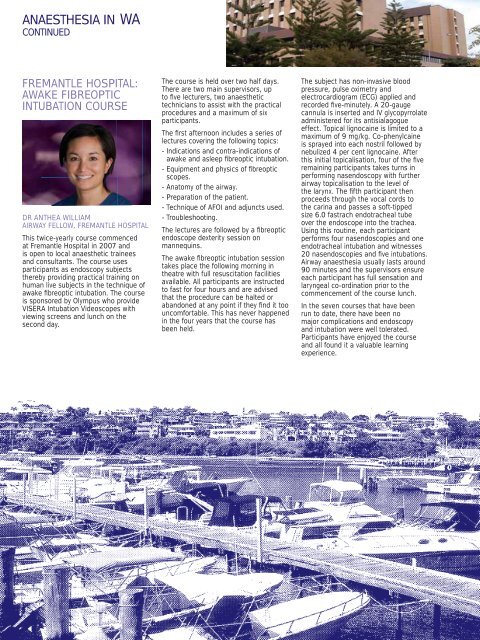ANZCA Bulletin June 2011 - Australian and New Zealand College of ...
ANZCA Bulletin June 2011 - Australian and New Zealand College of ...
ANZCA Bulletin June 2011 - Australian and New Zealand College of ...
You also want an ePaper? Increase the reach of your titles
YUMPU automatically turns print PDFs into web optimized ePapers that Google loves.
ANAESTHESIA IN WA<br />
CONTINUED<br />
FREMANTLE HOSPITAL:<br />
AWAKE FIBREOPTIC<br />
INTUBATION COURSE<br />
DR ANTHEA WILLIAM<br />
AIRWAY FELLOW, FREMANTLE HOSPITAL<br />
This twice-yearly course commenced<br />
at Fremantle Hospital in 2007 <strong>and</strong><br />
is open to local anaesthetic trainees<br />
<strong>and</strong> consultants. The course uses<br />
participants as endoscopy subjects<br />
thereby providing practical training on<br />
human live subjects in the technique <strong>of</strong><br />
awake fi breoptic intubation. The course<br />
is sponsored by Olympus who provide<br />
VISERA Intubation Videoscopes with<br />
viewing screens <strong>and</strong> lunch on the<br />
second day.<br />
The course is held over two half days.<br />
There are two main supervisors, up<br />
to fi ve lecturers, two anaesthetic<br />
technicians to assist with the practical<br />
procedures <strong>and</strong> a maximum <strong>of</strong> six<br />
participants.<br />
The fi rst afternoon includes a series <strong>of</strong><br />
lectures covering the following topics:<br />
- Indications <strong>and</strong> contra-indications <strong>of</strong><br />
awake <strong>and</strong> asleep fi breoptic intubation.<br />
- Equipment <strong>and</strong> physics <strong>of</strong> fi breoptic<br />
scopes.<br />
- Anatomy <strong>of</strong> the airway.<br />
- Preparation <strong>of</strong> the patient.<br />
- Technique <strong>of</strong> AFOI <strong>and</strong> adjuncts used.<br />
- Troubleshooting.<br />
The lectures are followed by a fi breoptic<br />
endoscope dexterity session on<br />
mannequins.<br />
The awake fi breoptic intubation session<br />
takes place the following morning in<br />
theatre with full resuscitation facilities<br />
available. All participants are instructed<br />
to fast for four hours <strong>and</strong> are advised<br />
that the procedure can be halted or<br />
ab<strong>and</strong>oned at any point if they fi nd it too<br />
uncomfortable. This has never happened<br />
in the four years that the course has<br />
been held.<br />
The subject has non-invasive blood<br />
pressure, pulse oximetry <strong>and</strong><br />
electrocardiogram (ECG) applied <strong>and</strong><br />
recorded fi ve-minutely. A 20-gauge<br />
cannula is inserted <strong>and</strong> IV glycopyrrolate<br />
administered for its antisialagogue<br />
effect. Topical lignocaine is limited to a<br />
maximum <strong>of</strong> 9 mg/kg. Co-phenylcaine<br />
is sprayed into each nostril followed by<br />
nebulized 4 per cent lignocaine. After<br />
this initial topicalisation, four <strong>of</strong> the fi ve<br />
remaining participants takes turns in<br />
performing nasendoscopy with further<br />
airway topicalisation to the level <strong>of</strong><br />
the larynx. The fi fth participant then<br />
proceeds through the vocal cords to<br />
the carina <strong>and</strong> passes a s<strong>of</strong>t-tipped<br />
size 6.0 fastrach endotracheal tube<br />
over the endoscope into the trachea.<br />
Using this routine, each participant<br />
performs four nasendoscopies <strong>and</strong> one<br />
endotracheal intubation <strong>and</strong> witnesses<br />
20 nasendoscopies <strong>and</strong> fi ve intubations.<br />
Airway anaesthesia usually lasts around<br />
90 minutes <strong>and</strong> the supervisors ensure<br />
each participant has full sensation <strong>and</strong><br />
laryngeal co-ordination prior to the<br />
commencement <strong>of</strong> the course lunch.<br />
In the seven courses that have been<br />
run to date, there have been no<br />
major complications <strong>and</strong> endoscopy<br />
<strong>and</strong> intubation were well tolerated.<br />
Participants have enjoyed the course<br />
<strong>and</strong> all found it a valuable learning<br />
experience.<br />
32<br />
<strong>ANZCA</strong> <strong>Bulletin</strong> <strong>June</strong> <strong>2011</strong>

















